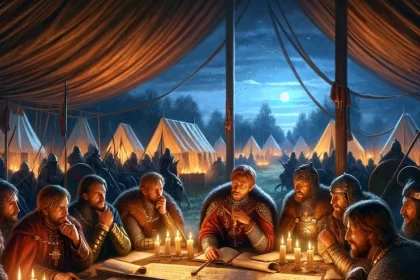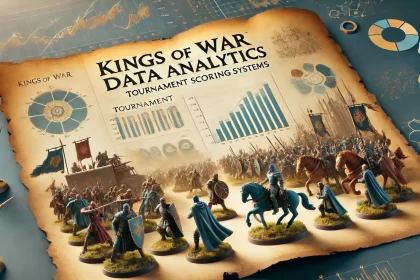This study was conducted using a custom-built Python combat simulator, designed to analyze unit effectiveness in Kings of War through 1.25 million combat simulations. The simulator included specific special rules to closely mimic actual gameplay dynamics. Key features of the simulation:
- Initiative and Randomization: Generally, faster units were programmed to strike first. However, to reflect the unpredictability of real-life combat, a randomizing factor was introduced, altering this sequence in some battles.
- Terrain Effects: In approximately 30% of the simulations, battles were set in varied terrain to account for the environmental impacts often encountered during gameplay.
These aspects were carefully integrated to ensure a balanced and realistic representation of combat scenarios in Kings of War.
Methodology
- Simulations: 250,000 matchups, each with 5 battles, totaling 1.25 million combats.
- Special Rules Included: Blast, Brutal, Cloak of Death, Crushing Strength, Dread, Elite, Fury, Headstrong, Iron Resolve, Lifeleech, Pathfinder, Phalanx, Piercing, Radiance of Life, Regeneration, Shattering, Stealthy, Strider, Thunderous Charge, Vicious.

ELO Rating System
The ELO rating system, used in this study, calculates the relative skill levels of units in Kings of War based on their performance in simulated combat.
- Initial Rating: Each unit began with a set baseline ELO rating. This standard starting point is common in ELO systems and ensures all units start from an equal footing.
- Rating Adjustments After Combat: After each combat, the ELO ratings were updated. The adjustment is made based on whether the unit won, lost, or drew, and how unexpected the outcome was, given the difference in ratings between the competing units.The process involves:
- Adding points to a unit’s rating if they win, especially against a higher-rated opponent.
- Losing points in the case of a defeat, particularly when losing to a lower-rated opponent.
- The amount of adjustment depends on the difference in ratings and the expected outcome of the match. A surprise victory or defeat leads to a more significant change in rating.
- Expectation Calculation: The system calculates the expected outcome of a match based on the current ratings of the two units. Units with higher ratings are expected to win more often against lower-rated opponents. If a high-rated unit wins against a lower-rated unit, the rating change is smaller, and vice versa.
- Effectiveness Determination: Once I had the ELO rating, I evaluated the ratio between cost and ELO to determine what units are over or undercosted.
This ELO system allows for a dynamic and responsive evaluation of unit effectiveness, reflecting not just the strength of the units but also the context of their victories and losses. Below, I ran a quick script to generate the top cost-effective units in each category.
Top 5 Cost-Effective Units by Size Category
- Horde (H): Lower Abyssals (Forces of the Abyss), Blacksouls (Ratkin Slaves), Blacksouls (Abyssal Dwarfs), Shieldbreakers (Dwarfs), Foot Guard (League of Rhordia)
- Legion (L): Charioteers (Kingdoms of Men), War Chariots (Elves), Fleabag Chariots (Goblins), Grogger’s Lugg Lads (Goblins), Fight Wagons (Orcs)
- Monster (M): Steel Behemoth (Dwarfs), Reanimated Behemoth (Empire of Dust), Tree Herder (Sylvan Kin), Tree Herder (Forces of Nature), Idol of Shobik (Empire of Dust)
- Regiment (R): Huscarls (Varangur), Huscarls (Northern Alliance), Order of the Abyssal Hunt (The Order of the Brothermark), Soul Reaver Infantry (Undead), Order of Redemption (The Order of the Green Lady)
- Titan (Ti): Red Goblin Slasher (Ogres), Goblin Slasher (Goblins), Ghekkotah Slasher (Salamanders), Iron Beast (Halflings), Hellfane (Abyssal Dwarfs)
- Troop (T): Huscarls (Varangur), Minotaur Chariots (The Herd), Warrior Chariots (Ogres), Huscarls (Northern Alliance), Order of the Abyssal Hunt (The Order of the Brothermark)
- War Engine (WE): Flame Belcher (Dwarfs), Ironbelcher Organ Gun (Dwarfs), Volley Gun (Halflings), Ice Kin Bolt Thrower (Northern Alliance), Volley Gun (League of Rhordia)
Conclusion
This study presents a data-driven analysis of unit effectiveness in Kings of War, factoring in a selection of special rules. Of particular note, units that can shoot from a distance and inflict damage before getting into melee perform very well on this metric. Note, however, that the metric doesn’t consider base size or nimble, so actually getting some of these units into combat can be a different ballgame altogether. That said, this quick analysis lays a foundation for understanding unit balance and informs strategy discussions within the game.






